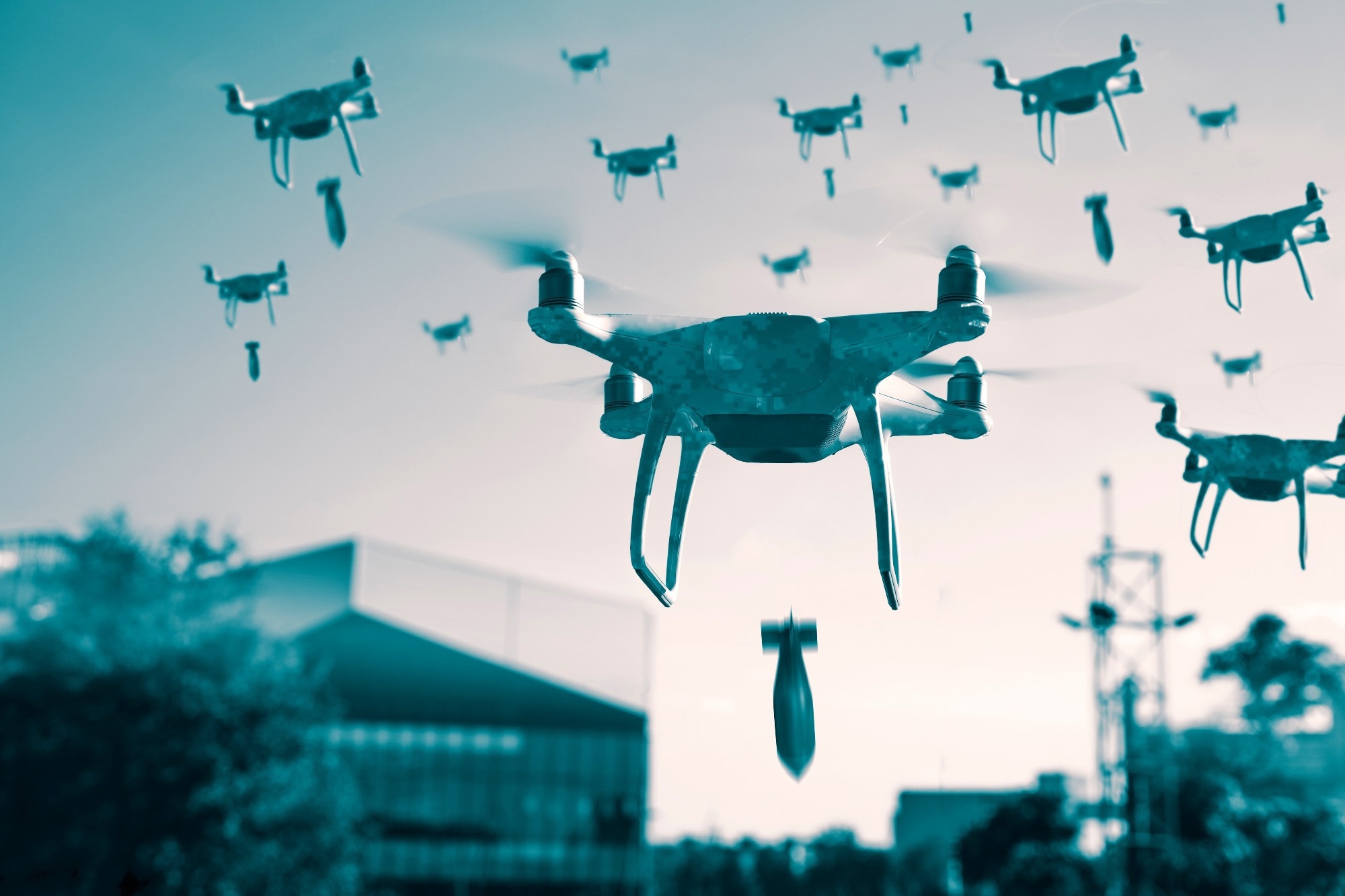In a recent paper published in the journal Communications Engineering, researchers proposed an innovative approach to enhance target detection and tracking in dense forests using a real-time particle swarm optimization (PSO) technique implemented by drone swarms with synthetic aperture (SA).
 Study: Invisible Targets Revealed: The Power of Adaptive Drone Swarms in Occluded Environments. Image credit: Phoenixns/Shutterstock
Study: Invisible Targets Revealed: The Power of Adaptive Drone Swarms in Occluded Environments. Image credit: Phoenixns/Shutterstock
Background
The concept of drone swarms involves intelligent collaboration among multiple drones to achieve complex objectives that would be difficult to accomplish individually. These swarms find various applications, including surveillance, target detection, infrastructure inspection, and exploration of disaster sites, particularly in remote and inaccessible areas. Controlling drone swarms can be centralized or decentralized, employing different algorithms such as heuristic-based or meta-heuristic approaches.
A key technology used with drones is SA sensing, which computationally enhances sensor measurements to mimic physically unattainable wide apertures. Airborne Optical Sectioning (AOS), a specific SA imaging technique, involves drones equipped with conventional cameras capturing images above forests. Subsequently, computational processing removes occlusion caused by vegetation, leading to improved target detection and tracking. Earlier sampling methods for AOS included sequential or parallel sampling by individual drones or large camera arrays, respectively. However, these approaches had limitations in adapting to changing forest conditions and occlusion densities.
To address these challenges, the researchers from the present study proposed the utilization of PSO. In this method, a swarm of autonomous drones explores optimal local viewing conditions for AOS sampling, continuously adapting to minimize occlusion and enhance target visibility. Despite the non-constant, highly random, and non-differentiable nature of the objective function, PSO proves particularly suited for this task.
Experiments were conducted to assess the efficacy of the adaptive swarm sampling approach using PSO compared to blind sampling methods in terms of visibility and time efficiency. Autonomous swarm sampling demonstrated superior results, enabling faster and more reliable detection of occluded targets. As a result, this approach proves beneficial for various applications such as search and rescue missions, wildlife observation, wildfire inspections, and security patrols.
Methods Used
The methods employed in the study focused on utilizing PSO for adaptive swarm sampling. PSO determines particle positions based on velocity vectors, relying on hyperparameters such as inertia weight constant (c0), cognitive coefficient (c1), and social coefficient (c2). The objective function's non-linear, non-smooth, and non-differentiable characteristics make PSO suitable for this purpose. To ensure exploration, the swarm behavior was constrained to the current time instance, and particles remained dynamic to avoid convergence to a single position. In cases where no target was found or lost, the default scanning pattern was employed. Collision avoidance was achieved by operating drones at various altitudes while maintaining minimal impact on spatial resolution in integral images.
The objective function involved capturing n times t single images with n drones over t time instances. An anomaly detector was applied to identify abnormal pixels in four spectral bands (RGB+thermal). After detecting anomalies, they were consolidated and concealed, and subsequently, the optimal integral image was identified based on the highest objective score, corresponding to the size of the largest connected pixel cluster's contour.
Hyperparameters governed PSO iterations to ensure a balance between exploration and convergence. The implementation utilized WebGL for forest simulation, and the centralized approach achieved an average processing time of 96 ms for parallel samples and 30 ms for sequential samples on a consumer PC.
Study Results
The results of the experiments showcased the effectiveness of adaptive swarm sampling using PSO in detecting targets in occluding forests. Different spectral bands, forest occlusion densities, and sampling procedures, including single drones, camera arrays, and swarms of drones, were simulated during the experiments. The objective function was to determine target visibility as a percentage of the highest possible visibility.
Compared to previous blind strategies, the adaptively sampling drone swarms demonstrated significant improvements in visibility and reduced sampling time. The size of the swarm also played a role, with larger swarms providing better results but potentially facing limitations in field-of-view coverage. Visibility decreased as forest density increased due to denser occlusion.
Moreover, the experiments showcased the swarm's capability to detect and track moving targets, with estimations of target position, motion speed, and direction closely aligned with the ground truth. The swarm dynamically adapted its behavior based on the local occlusion situation and target movement.
Conclusion
In conclusion, the experiments demonstrated the superiority of swarms over blind sampling strategies in terms of performance and detection rate. Swarms autonomously adapted to sparse forest regions and maximized target view obliqueness, resulting in faster and more effective detection. The wider swarm area and denser sampling further improved visibility and detection probability.
For static targets, visibility increased with the number of integrated images, while for moving targets, the integration of images from previous time steps enhanced visibility in cases where target projections overlapped. While the approach proved reliable for tracking moving targets, challenges existed in excessively dense regions or due to fast movements. The simulation, though simplified, validated the advantages of swarms in occlusion removal.
Future work will involve deploying physical drone swarms in real environments, exploring variations of swarm approaches, and investigating collision avoidance strategies to reduce minimal sampling distances. The authors hope that ongoing technological advancements will make large drone swarms feasible and effective for various applications, including search and rescue scenarios and dynamic remote sensing scenarios.